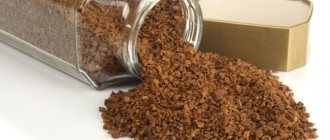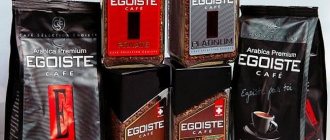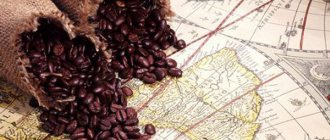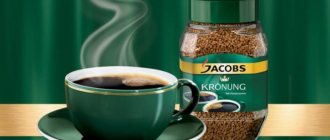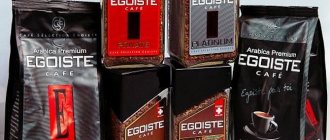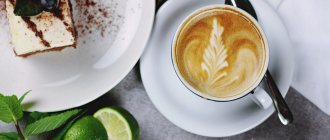A red cup with white Nescafe letters in the hands of an astronaut, an alien, and even in the paws of a polar bear at the North Pole - all kinds of advertising stories have been shot by the owners of the instant coffee brand. And the effect has been achieved: the first brand that is named in response to a question about an instant drink is “Nescafe”. Trendy images of coffee stories - a girl waking up to the aroma of coffee, an optimistic hockey player for whom “everything starts with Nescafe”, a father and son on a morning fishing trip with the same red branded mugs, all of them are about Nescafe instant coffee.
In 2022, the brand turns 80 years old. 4,500 cups of Gold, Classic, Sensa, Espresso and other types of Nescafe are drunk every second in the world - from glass and tin cans, from vacuum bags and 3-in-1 stickers. Over 80 years, the brand has evolved from an ordinary can to a full range , including coffee systems. Today there are active sales in 180 countries around the world, but there are only 197 of them. But the company is not going to stop there.
The history of Nescafé coffee
In 1929, Nestlé faced the difficult task of helping to preserve the surplus of coffee beans in Brazil that resulted from the Wall Street Crash. And Nestlé accepted the challenge.
Nescafe brand
We are indebted to the staff of the Brazilian Coffee Institute. The fact is that by the beginning of the 30s of the last century, Brazil, being the largest coffee producer in the world, was experiencing serious problems with overproduction of green coffee, which had been going on for several years. Manufacturers dried coffee beans and subjected them to primary processing, but, lacking technology for processing and storing beans, they ended up losing a colossal amount of reserves.
At that time, Nestlé was already a recognized leader in the development and production of food products, so it was able to carry out such a responsible task perfectly.
And so, over the course of seven long years of laboratory experiments, coffee guru Max Morgenthaler and his assistants, again and again, looked for a way to prepare high-quality coffee and preserve its natural aroma.
Failures constantly alternated with small discoveries, when finally the answer was found!
Exactly on April 1, 1938, the world first heard about instant coffee produced in industrial conditions.
Of course, it was Nescafé, whose name comes from a combination of such simple words as Nestlé and Cafe .
The first production of the drink was launched at a factory in the Swiss town of Orb, which is 50 km from Nestlé headquarters located in the city of Vevey.
It was from this, as it turned out, serious date that the company’s leadership in the production of instant coffee began.
Who is the freeze-dried drink contraindicated for?
First of all, people who have problems with the stomach, pancreas, liver, and intestines will refuse instant coffee. The chemicals are dangerous for people with kidney failure: this means that the filtering glomeruli of the kidney parenchyma do not function properly, causing toxins to remain in the blood and damage other organs. Any external poisoning, including food chemicals, can lead to kidney failure.
Atherosclerosis is a problem for older people. They have a pronounced narrowing of blood vessels, there is a risk of blood clots, strokes and heart attacks. This state of affairs is caused by a lack of attention to health among young people: consumption of products containing trans fats and chemical additives.
Nescafe coffee range
The range of flavors is so diverse that, perhaps, everyone will be able to find their ideal option. Today the company produces about 140 varieties. Let's look at a small part of them:
- Classic. The rich smell and rich bitter taste can charge you with positivity for the whole day. For its production, they take selected Brazilian varieties of Robusta and Arabica, collected on elite plantations. Available in tin cans of various weights
- Gold – belongs to the “premium” category. Gourmets note its incomparable caramel aroma at the time of preparation. The taste is mild due to the light roasting. Composition: Robusta and Arabica. Packaged in glass containers and soft bags
- Gold Decaf is produced using special technologies, due to which the beans retain their excellent qualities for a long time; there is practically no caffeine in its composition. Packaged in glass jars
- Espresso is made from selected Arabica beans. In terms of its organoleptic characteristics, it is similar to Italian coffee. The grains are all perfectly shaped, thanks to a special cooking technology. It is Espresso that is more similar to a freshly brewed drink. Available in glass containers and soft packaging
- Alta Rica - made from Latin American varieties. The tart aroma and delicate almond taste give an unforgettable feeling of pleasure. Distributed in glass jars and soft containers
- Cap Colambi - beans are collected on the best plantations in Colombia, after which they undergo delicate roasting. The taste contains notes of fruit. Packaged in glass jars
- Green Blend – it contains 2 types of green coffee beans – roasted and unroasted. Therefore, the drink is considered the elixir of youth. The antioxidant content in Green Blend is exactly the same as in green tea. The taste deserves special attention; it is very unusual. In every sip you feel incredible freshness and tenderness.
- Montego is a mix of Colombian Arabica and Brazilian Robusta. The drink has a slightly sharp aroma with caramel tones and a tart taste with bitterness.
- Espiro - for its production, elite varieties of grains are taken, which are subjected to special roasting. The freshly prepared drink has a very mild taste and a “thick” aroma. On the shelves Espiro can be found in glass jars weighing 50 and 100 grams
- Excella – if you are a connoisseur of fine drinks, then you should drink this unique variety. To make it, grains are collected on plantations in Japan, which are subsequently sent for special processing: “spri dry”, then the grains are roasted until they are dark chocolate brown. Coffee retains its special taste even when cold. It has a velvety taste and amazing aroma. Distributed in glass jars of 0.2 kg
- President - Elite Japanese coffee, produced by the Nestlé branch in Yokohama, a favorite of gourmets. Created from a mixture of Colombian Arabica beans, it has a delicate aroma and slightly spicy taste with bitterness.
- Esthete – consists of pure Arabica coffee, the caffeine content is at an average level. The beans undergo intense roasting, which gives an extraordinary taste and aroma. Packaged in glass containers of 0.1 kg
- Brazero - for its production, they take the highest quality varieties collected on elite plantations. It contains a large amount of caffeine, therefore the taste is very strong, rich aroma. Sold in stores in cans weighing 0.1 and 0.3 kg
- Kenjara - Arabica beans are collected on the best Kenyan and Costa Rican plantations. They are lightly roasted. Freshly prepared coffee has a delicate aroma and rich taste. Coffee crystals have a golden color and are packaged in glass containers
- Turbo is a coffee drink consisting of sugar, milk and coffee. There are 20 sachets per pack
- Extra Strong - 70% caffeine in the drink, coffee is packaged in sticks. The drink turns out to be very invigorating and aromatic.
- Mate – available in various containers, including sticks. The prepared coffee has a creamy taste and light aroma.
- Dolce Gusto – coffee is packaged in capsules, which are subsequently used in special coffee makers. There are 16 varieties of capsules, each of which contains an exclusive taste and mesmerizing aroma.
Each category is divided into subcategories, for example, Dolce Gusto coffee capsules can be purchased in the following flavors:
- espresso;
- fmericano;
- cappuccino;
- cold cappuccino;
- chocochino;
- lungo;
- latte macchiato.
Classic Crema coffee is the most popular in the collection. The drink has a medium strength, thick and delicate foam, and a pleasant aroma. It is perfect for consumption during the day. Classic cream goes well with milk and is suitable for preparing various coffee drinks.
The brand's products can be purchased in soft packaging, a glass or tin jar, or as a gift package with a mug or spoon. The company produces coffee machines.
Types of Nescafe
There are now a lot of types of instant coffee from the brand. All this is done to ensure that every buyer finds something for himself, and you can choose from:
- Classic. A classic blend of Nescafe, made from Brazilian Arabica and Robusta. Moderately strong, with moderate bitterness, aromatic, rich. Good classic instant coffee with high caffeine content.
- Espiro. Instant coffee made using a special technology that makes it much closer to natural coffee. There is almost no bitterness in the taste, but there are pleasant caramel shades and a rich aroma.
- Gold. This coffee is not overly roasted, so it has light-colored granules and a more delicate taste than other blends. There is sourness, a light caramel aroma and a little bitterness.
- Espresso. Arabica from Guatemala and Nicaragua, with a soft, slightly sour taste and rich aroma. The coffee, although instant, tastes very much like coffee made in a coffee machine; the finished drink even has a characteristic foam.
- Cap Colombie. Colombian Arabica, well roasted, with a sweetish taste and fruity notes.
- Alta Rica. The spicy aroma and light almond notes of this coffee make it an ideal choice for making cappuccino or mochaccino. The variety was created in France, and the grains used for it are from Latin America.
- Montego. A blend for connoisseurs of a harsh aroma with caramel tones. Tart, slightly bitter, made from Brazilian Robusta and Colombian Arabica.
- Excella. Japanese coffee dried using a special technology, which is unique in that it retains a rich taste with a slight sourness even when cold. And in terms of aroma, it is no different from freshly roasted coffee beans.
- Kulta. A highly caffeinated variety created in Finland from Latin American beans. In addition to its high strength, it has a tart nutty flavor and a caramel aftertaste.
- President. An elite blend originally from Yokohama, Japan. Its subtle, slightly spicy aroma and taste make it popular even among coffee gourmets who are not particularly fond of instant coffee.
- Koumibaisen Kilimanjaro. Another premium Japanese coffee created in Yokohama. It has a high level of caffeine and a bitter taste, and is made from beans that grow on the slopes of Mount Kilimanjaro, hence the name of the blend.
- Kenjara. Beans from Kenya and Costa Rica, produced in France, this blend has a slightly bitter taste, a pronounced fruity hue and a rich taste.
- Mokka Blend. Mocha, originally from Ethiopia, will delight coffee connoisseurs with hints of chocolate in its taste.
- Estet. This variety is for those who need less caffeine, and this coffee can be used to make an excellent cappuccino. The base is well-roasted Brazilian Arabica.
- Extra Strong. Very strong instant coffee, which gives a strong tonic effect. The taste of the blend is not too bitter as one might think.
- Mild. The famous 3-in-1 instant coffee, which contains milk powder and sugar. An excellent choice for those who appreciate mild taste and sweetness.
- Dolce Gusto. Capsules for coffee machine. There are 16 types of them, with different tastes and varieties, but we will not describe them all.
Nescafe instant coffee has already become something much more than just dried and specially processed coffee beans. This is a trademark known all over the world; you will recognize the signature red mug everywhere, and slogans from advertising will be remembered for many years. But the main thing, of course, is the invigorating taste and high quality of the drink.
Characteristics of Nescafé Classic coffee
There are dozens of species of coffee trees in the world, but only two of them are familiar to each of us. The first one, Coffea arabica or Arabica
, differs from other varieties in a more complex aroma.
The second commercial species is Coffea Canephora, or robusta.
. It is characterized by a higher caffeine content. Used in coffee blends to add strength to the drink. Unlike Arabica, this type of coffee tree is more resistant to diseases, pests and high temperatures.
And although Arabica today accounts for approximately 70% of all coffee trees, Robusta plantings are constantly increasing. This is because it is easier to grow and has a higher yield.
Every day, a third of the world's population consumes several tons of coffee.
But you will never find two countries that serve this divine drink in the same way. The new Nescafé Classic is made from selected robusta beans grown on tropical plantations in Brazil.
This is coffee with a strong bitter taste and a strong coffee aroma. It is prepared using advanced technology that helps preserve even more coffee aroma in each can.
Thanks to this technology, the coffee aroma is “collected” during the roasting and grinding stage and is stored at low temperatures in coffee oils, and added to the granules during the final stages of processing and packaging of the product.
Elite varieties
High-quality coffee beans cannot be cheap - true admirers of natural drinks know this. The market has formed a rating of the best manufacturers who care about the high quality of all types of grains and packaging for their storage:
What types of elite coffee are there? The best of them are described below.
Jamaica Blue Mountain is one of the leaders among elite varieties. The beans of this variety have a blue-turquoise hue. The grains are very aromatic, giving the drink a nutty flavor. The drink is too versatile in terms of aftertaste and has good acidity. Due to the fact that the bulk of this rare coffee is purchased by Japan, it is impossible for the average coffee lover to purchase it on the market.
Kopi Luwak is considered one of the most expensive. Produced in Indonesia. A local rodent, nicknamed luwak, is directly involved in its production. It eats ripe coffee beans, and from its feces, partially digested coffee beans are extracted, which are roasted and ground to create a gourmet drink.
Old Java is the so-called aged coffee. It is obtained after 6 years of storing grains under certain conditions. The drink obtained from them has a thick consistency and unusual aroma.
Coffee varieties are a very broad concept. It is difficult to describe their exact number, but we were able to describe the majority of those on the market in this article.
Exotic coffees
For a long time, Kopi Luwak was considered the most expensive and exotic type of coffee. The luwak grains processed in the stomach of the animal got rid of natural bitterness and acquired an interesting chocolate flavor. The aromatic variety of coffee is obtained without the involvement of breeders and the latest technologies - the animal eats only the ripe, best fruits. Price – from 400 to 1000 $/kg.
There is a cheaper version of a rare variety of coffee - Monkey Coffee, obtained by Taiwanese farmers. The technology is similar to the first type, but Formosan monkeys are used to process the grains. This significantly reduced the price to $45-50/kg. The finished drink has a pronounced vanilla flavor.
Package
The brand's products can be purchased in soft packaging, a glass or tin jar, or as a gift package with a mug or spoon. The company produces coffee machines.
Alegria machines, which are designed for home use and are suitable for cafes and kiosks with light loads, have earned great popularity. Alegria machines use ground coffee and make it possible to prepare several types of delicious drink.
Nescafe is the undisputed leader, which follows the right marketing policy, monitors quality and offers additional accessories to maintain its image. It is preferred by millions of people around the world, and almost everyone recognizes the logo.
Packaging: 900 g
The drink, placed in a zipper bag with a volume of 900 g, is suitable for the office, dining room, cafe. Savings are noted, since it is designed for 450 servings, taking into account the fact that 2 g of product is consumed in a 150 ml cup.
There is no need to use any additives; it can be taken as a stand-alone drink.
To make products, the best grains are selected by sorting, then roasted, ground, and then water is added
Moisture is removed by a sublimated method, obtained by evaporating frozen water, this process takes place before it turns into liquid.
Store in a cool, dry place, the temperature should not exceed +20°C, humidity should not exceed 75%.
The shelf life is 24 months from the date of production.
Interesting facts about instant coffee
- About 2.25 billion cups of coffee are drunk around the world every day, and more than half are instant coffee.
- Instant coffee was invented by the Japanese chemist Satori Kato in 1901, and two companies even began producing it. But the drink turned out to be so tasteless that there were few buyers and they stopped producing it. The Nestle company has improved the manufacturing process and achieved minimal losses in the quality of the original product - coffee beans.
- A sign of high-quality instant coffee is good solubility in both hot and cold water. Instant coffee, which dissolves quickly without leaving sediment, will be of the highest quality.
- The most popular and best-selling coffee brand in the world is Nescafe instant coffee, produced by Nestle. It is a top seller in more than 80 countries.
- A cup of instant coffee contains approximately 60 g of caffeine, while grain coffee contains 80 g.
- The Robusta variety is often used in the production of instant coffee because it is cheaper and contains more caffeine. Some producers mix it with more expensive Arabica.
Today, Nescafe is a recognized leader in coffee markets in more than 83 countries.
Raw materials and production process
The most common coffee varieties are Arabica Robusta. Robusta beans are distinguished by a high caffeine content, which gives the coffee strength and a pleasant, rich aroma and bitterness. Arabica, on the contrary, is characterized by a small amount of caffeine and contains more essential oils. It has a mild taste and a sweetish aftertaste with sourness.
Coffee beans are carefully collected by hand
The process of collecting coffee beans has not changed over time. The grains are still collected by hand. They are then cleared of their outer shells. Next, usually by hand, the best quality grains are selected to go into production. The main plantations are located in Brazil, Indonesia, Peru, Colombia, Vietnam, i.e. in the coffee belt countries.
In coffee factories, instant coffee is produced mainly in two ways. The first one is more budget-friendly and is called agglomeration. The resulting beans are ground in large coffee grinders, the resulting powder is diluted with water, resulting in an extract that is exposed to hot air, the water from the solution dissolves and soluble coffee granules remain.
Grinding of grains is done in large machines
The second method is more modern - freeze drying. But its costs are significantly higher than those of agglomeration. The method involves freezing the coffee extract and then using hot air and vacuum to dehydrate the extract. The coffee breaks into small pieces that resemble broken ice. This type of preparation preserves the taste, aroma and beneficial properties of coffee as much as possible.

